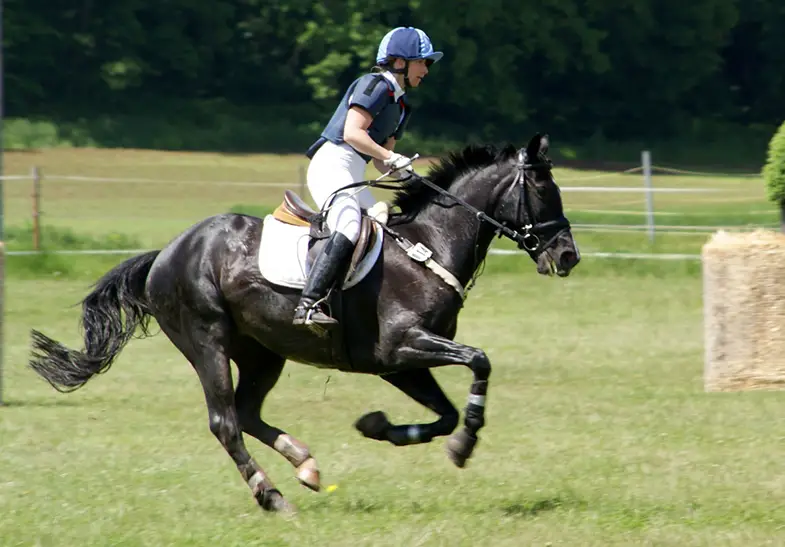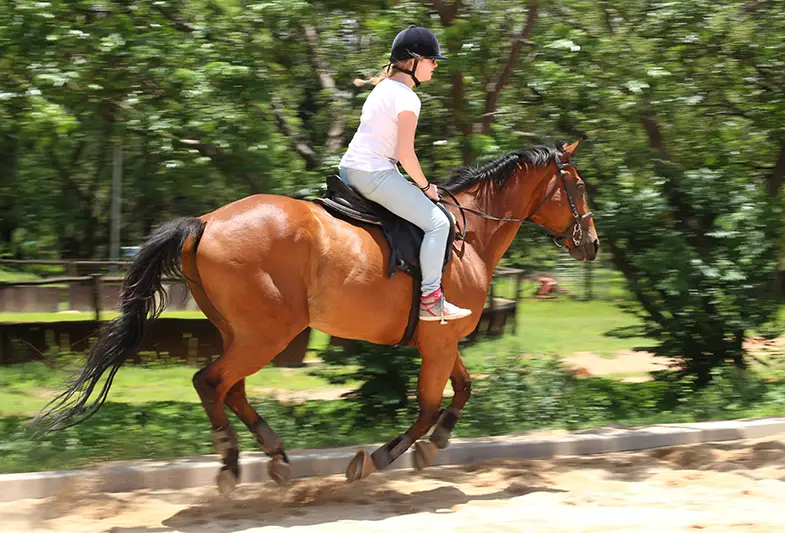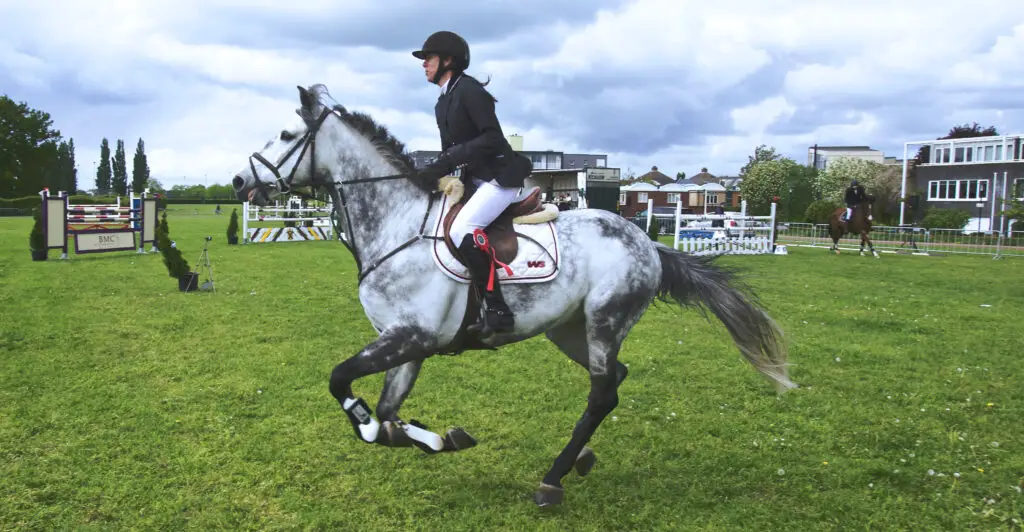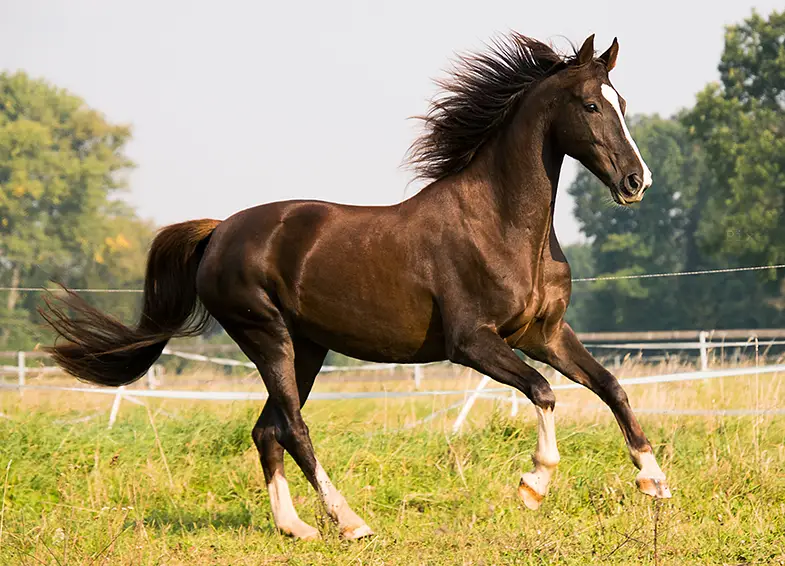Having spent many decades teaching hundreds, if not thousands, of people of all ages to ride I’m always struck by how keen people are to progress and learn themselves. While there’s no substitute for the real thing, having an idea of what to expect will always help you to learn more quickly which is why I decided to create this series. My goal is to give you a good understanding of what to expect (and what you can do to improve) in every gait.
After you’ve learned to control a horse at a walk and trot it’s time to move up a gear and learn how to ride a horse at a canter. Surprisingly the canter is actually easier to learn than a trot but that doesn’t stop people from getting nervous. In this article, we’ll look at what you need to do to transition your horse to a canter as well as how you should move with the horse. We’ll also look at things you can do to improve your position in the saddle and make your canter a more exhilarating experience.
What is a canter?
Sometimes (wrongly) referred to as a slow gallop, the canter is a smooth rhythmic gait that allows the horse to cover a lot of ground quickly. Unlike the walk and trot, which are both even beat gaits (being four and two beat respectively), the canter is an odd three-beat gait where the horse uses one of their hind legs to propel themselves forward.
When cantering, a horse can lead on either his left or right leg and this will set the order in which his legs move. For example, if he’s on a left lead then he’ll move off with his right hind while the rest of his legs are in the air. Next his left hind and right front legs will hit the ground at the same time followed by his left front foot as the right hind leaves the ground. Lastly his left hind and right foot also leave the ground just before there’s a moment of suspension (where all feet are off of the ground) before the whole process is repeated.
Want to know more about horse gaits? Understanding how horses move.
How do you ask a horse to canter?
While you can go from a walk to a canter, when you first learn to canter it’s best to start with a good, calm sitting trot. This will help to control your horse’s speed and make the transition smooth.
Once you have a steady sitting trot you can then ask them to pick up the pace with your legs, seat, and voice.
Reins
As a horse moves up through the gears it’ll bend its neck slightly which is why you’ll need to shorten your reins slightly. This will allow you to continue to give effective cues to your horse. It’s worth pointing out though that, if you ride Western style, then you don’t need to shorten the reins at all, in fact, they should remain loose.
Not sure what style of riding is best? Differences between Western and English riding.
Legs
Just like with every other pace you’ll need to squeeze your horse slightly with your legs but unlike with other gaits, your legs won’t be in quite the same place. In order to help your horse move off on the correct leg you need to keep your inside leg on the girth, but move your outside one back a fraction. Doing it like this will also encourage your horse to bend around your inside leg.
Seat
Shifting your weight into the saddle while keeping your body upright will help you secure your seat. Like the rest of your body, your hips should be relaxed, and allow them to move in time with the movement of your horse. Believe it or not, you can also use your pelvis motion to control your horse’s speed, by adjusting the tempo of your hips your horse will also alter his pace. If you move slower your horse will slow down, likewise, if you speed up so will your horse.
Voice
Some horses have been trained to respond to sounds or verbal cues, such as a clucking or clicking sound or the word ‘canter’. If this is true of your horse then you can also use them to reinforce your other natural aids.
As soon as your horse moves into a canter you should release the pressure your legs were applying, if you don’t your horse will think you want to go fast. If necessary you can always reapply the pressure if your horse starts to slow down.
What’s the correct position for riding a horse at a canter?
While the canter is a lot smoother than a trot it can still be quite bouncy if you’re not used it to and it’s also possible that you might lose your stirrups. Don’t worry this is perfectly normal and happens to most riders when they canter for the first time. Learning to maintain the correct position will not only help to stop you from bouncing but it’ll also ensure your feet remain firmly in the stirrups (unless of course, you choose to take them out).
The correct position should be:
Head
It can be tempting to look down, especially if you’re nervous, but try and resist doing this if possible otherwise, you’ll find both your body and your center of gravity moving forward. Instead, keep your head up and your eyes looking forward. Looking forward will help you to see where you’re going but it’ll also make it easier for you to keep your head up.
There should be an imaginary straight line from your ears to your shoulders, hips, and then onto your heels.
Shoulders
You might not think that your shoulders will have a barring on your horse but if your shoulders are tense then your arms and hands will be too which will affect the contact you have with your horse. This will make it harder to control him but will also mean you’re bouncing around in the saddle more. If your shoulders are relaxed and back then you’ll have a better seat and will therefore be able to move in time with your horse.
Elbows
As with your shoulders, if your elbows are tense then you’ll be putting unnecessary pressure on your horse’s mouth, resulting in a loss of control. Instead, keep your elbows relaxed and by your side, they should also be bent so that there’s a straight line from them through your hands to your horse’s mouth.
Hands
Your hands should be soft, relaxed and should follow the motion of the horse’s head and neck, don’t move them too far but allow them to gently move as your horse moves.
When you first start to canter it can be difficult to keep your hands still but don’t worry if this is the case, you can either hold onto the saddle (although you should lengthen the reins a little if you do) or use a neckstrap. This is a simple strap that sits around your horse’s neck and is designed to give you something to hold on to, allowing you to steady yourself without pulling on the reins.
Back
Your back should be tall and straight to help secure you in the saddle, you should also keep your body upright rather than lean forward or tip back. This will enable you to keep your balance and move in time with your horse.
If you tip forward you’ll unbalance both yourself and your horse while leaning back will put you out of kilter with your horse, meaning you’ll be constantly trying to catch up with him. If you find it difficult to keep your upper body still then working on improving your core will help.
Need to improve your inner strength? Core exercises equestrians swear by.
Seat
It can be tempting to rock backward and forth but this will only unbalance your horse, instead relax your hips and gently move them in time with your horse. You can also the tempo of your hips to control your horse’s speed, the slower you move the slower they will, and vice versa.
Legs
It’s common to lose your stirrups when you first learn to canter but this is due to you being tense and not relaxing. I know it can be difficult but relax your legs and make sure your weight is down in your stirrups, allowing your ankles to move but not your feet.
You should also avoid gripping your horse with your legs, let them hang loosely while maintaining a light contact.
Feet
As with any other gait, your heels should be down and taking the weight of your legs, this will not only help you to keep still in the saddle but will also enable you to have a secure seat.
Relax
How we feel is one of those things that’s often overlooked but it can play such a big role in how you ride and how your horse feels. After all, horses are very sociable animals that feed off of each other’s emotions, therefore if you’re calm your horse will be too.
Personally, I find using the mindfulness app on my watch helpful, it forces me to take a moment to calm myself and relax. Even if I don’t think I’m feeling tense I still like to use it, and I know my horses are grateful that I do.
How do you move with the horse at a canter?
It can be tempting to ride a canter like you’re on a rocking horse and move your whole body but this will only help to unbalance you and make life harder for your horse. Instead, you need to keep your upper body straight (but not rigid) and your legs resting (but not squeezing) against your horse’s side.
As your horse moves his hips will rise and fall as he propels himself forward, if you’re relaxed you’ll find that this rise-and-fall motion naturally moves you forward and you should go with it, being careful to only move your hips rather than you’re entire body.
How do you stop a horse that’s cantering?
Before you begin to canter you should have already learned how to stop them and while those principles will still work when cantering there is also another way to stop a horse from cantering.
Rather than using your hands to signal to the horse to slow you need to sit deeper into the saddle and close your legs against his side. If your horse has been trained properly then he’ll understand that you want him to slow and return to a trot.
How do you improve your position when riding a horse at a canter?
Cantering for the first time can be a scary experience and it might feel like you’re bouncing around all over the place but the more you relax the less you’ll bounce.
I know that it can be difficult to relax when you feel that you’re going to bounce out of the saddle at any moment but focusing on your breathing will help you to relax. Holding your breath or taking short, shallow breaths will cause your muscles to tense up. I found that singing out loud (or with others) helps to keep you breathing, after all, you can’t sign if you’re not breathing.
Another thing that can really help you to relax is to wear a body protector and riding helmet. I know that might sound silly but most people are tense because they’re worried they’ll fall off ad hurt themselves. If you’re wearing the right protective gear then you’re greatly reducing the chances of getting hurt. Believe me, it really works, I did it myself when I was first learning.
Checking your stirrups will also help you to ride a bounce-free canter, if they’re too long you’ll end up gripping with your thighs and knees but if they’re too short then you’re hips can’t relax and you won’t be able to move with your horse.
So what’s the right length for your stirrups? To be honest it depends on whether you’re riding English or Western. If you’re riding English then take your feet out of the stirrups and relax your legs, the bottom of the stirrup irons should be level with your ankle. If, however, you’re riding Western then your stirrups should be long enough to allow you to tip your toe forward to get your foot into the stirrup (with your knee bent slightly).
As silly as it sounds but riding without stirrups from time to time can also help to improve your position when cantering. The reason for this is that it forces you to use your core to maintain your posture, as an added bonus this will also build up your stamina.
Want a quick recap? Learn how to ride a horse at a trot.
I hope you found this article helpful. If you did I’d be grateful if you could share it please as it would really help me.
Recommended products
Over the years I have tried hundreds of different horsey products, from various blankets and halters to different treats. Some I’ve loved, others I’ve hated but I thought I’d share with you my top all-time favorite products, the ones I never leave the yard without. I’ve included links to the products (which are in no particular order) that I really think are great.
- Horse Knots by Reference Ready – If you’re like me and enjoy pocket reference guides then you’ll love this knot tying guide. These handy cards can easily fit in your pocket or attach to the saddle for quick reference. They’re waterproof, durable and are color coded to make them easy to follow.
- Mane ’n Tail Detangler – Even if you never show your horse you’ll need to detangle his tail from time to time (and possibly his mane too) which is always a challenging chore! I’ve found that if I run a little bit of detangler through my horse’s tails every few days it stops them from getting matted up and makes combing them easy, even if they’re coated in mud. I don’t know if I should admit to this or not but it also works wonders on my hair.
- TAKEKIT Pro clippers – Over the years I’ve tried a lot of different clippers and while some were obviously better than others I found these to be by far the best. They are heavier than a lot of other clippers but for me, that’s a good thing, it makes them feel more sturdy and hardwearing. On top of that they have a range of speeds so are just as good for clipping your horse’s back as they are his face. I also like the fact that they come in a handy carry case but that’s not for everybody. The company that makes them is super good and incredibly helpful too, a real bonus these days. The only thing I wasn’t keen on was the fact that it doesn’t come with any oil, but that’s not a major problem as it’s not difficult to buy lubricant.
- Shire’s ball feeder – There are so many boredom buster toys out there but I like to use these every day, regardless of whether or not my horses are bored. I find that it helps to encourage my horses to problem solve by rewarding them with treats (or pieces of fruit) but it also mimics their natural grazing behavior which helps to keep them calm and de-stressed.
- Horse safe mirror – This is a strange one that many people are surprised about but I like to put horse safe mirrors in the trailers as well as in the quarantine stalls. It helps to prevent the feeling of isolation by giving the impression of other horses being around. Being herd animals horses can get extremely stressed when they feel that they’re on their own but with these stick-on mirrors, they believe that at least one other horse is with them.
- Rectal thermometer – I know this isn’t glamourous at all but it’s vital for your horse’s well-being to be able to check their temperature and a rectal thermometer is the easiest way of doing this which is why I’ve added it to the list.
Shopping lists
I’ve also put together a few shopping lists of essential items that I’ve found helpful over the years. I’ve broken the lists down into different categories rather than put everything in one massive list 😉




